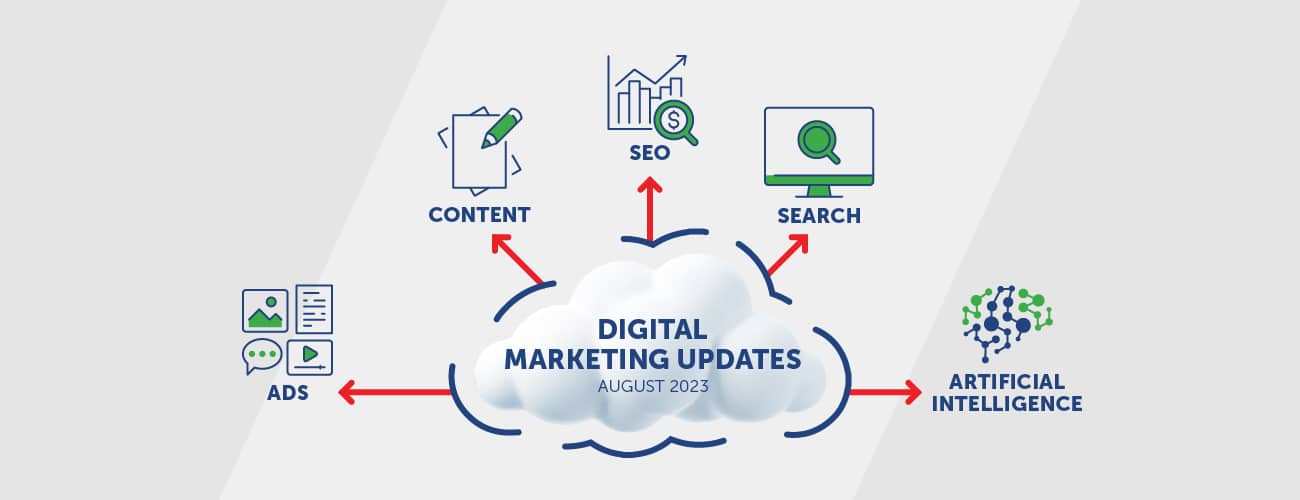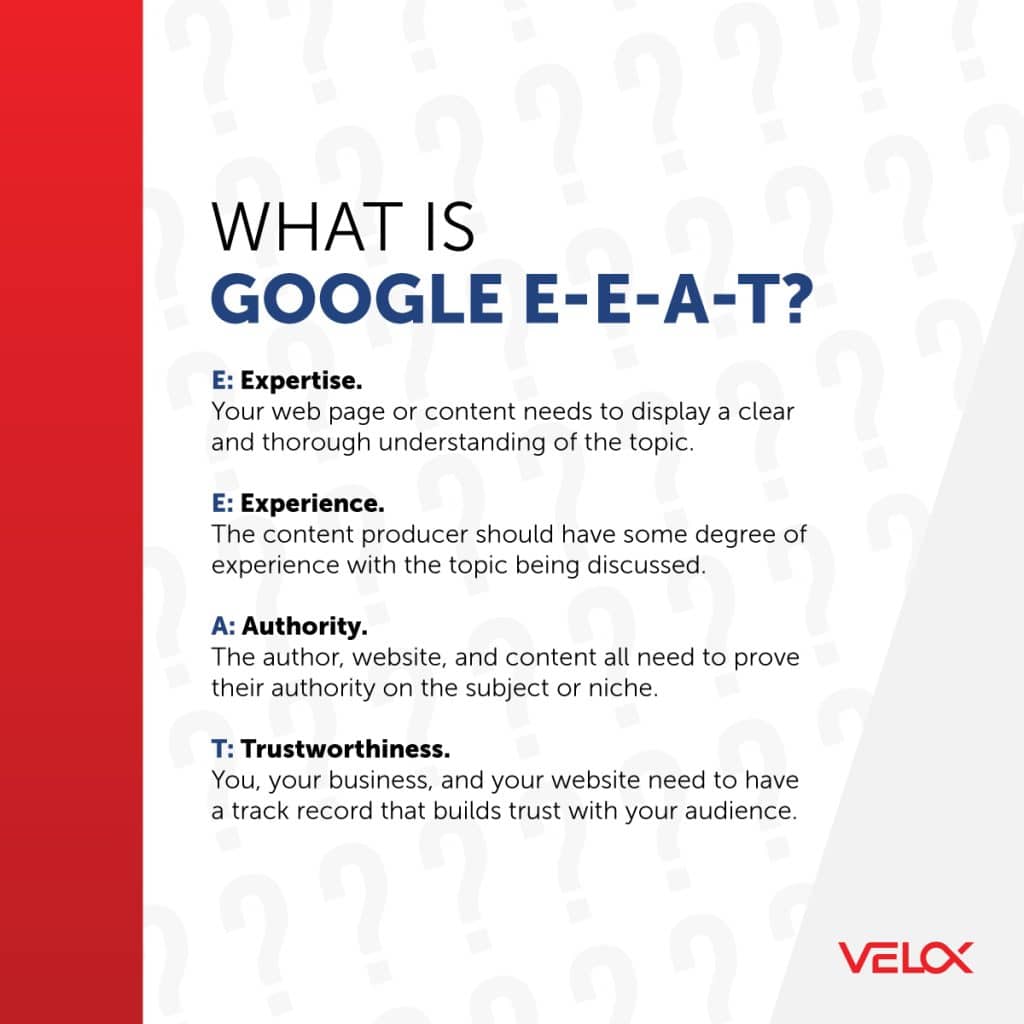
September 7, 2023
5 Crucial SEO & Digital Marketing Updates From August 2023
The month of August 2023 brought with it a number of important changes to the world of SEO and digital marketing. From the impact of AI in SEO to Google’s drive to provide more valuable search results, these updates and alterations are already having tangible effects.
Whether you’re an established eCommerce giant or a B2B enterprise, each digital marketing adaptation makes a difference in your efforts to capture more site traffic for more conversions and improved revenue. It’s vital to stay ahead of the curve and evolve before your competitors to maximize your market share.
Use this list of digital marketing updates from August 2023 to stay abreast of the top-line news that matter to your brands and customers.
Let’s dive right in with a recap of the most significant change we’ve seen in recent months: Google’s latest broad core update.
Google Rolls Out August 2023 Broad Core Update
With each broad core update from Google comes a chorus of exasperated exhales from SEO professionals. These updates typically result in search result shakeups that cause serious concern for some site owners.
Ask 10 of your fellow digital marketing pros about this latest update, and you’ll likely get 10 different opinions. Some say they’ve seen less volatility than with previous core updates, while others experienced massive traffic declines.
Google hasn’t told us exactly what the August 2023 broad core update entails, but it’s safe to assume that it’s designed to work in furtherance—at least, to some extent—of the Helpful Content Update that Google rolled out at the end of 2022.
What Does The Latest Google Update Mean for Site Owners?
If your site hosts informative, user-oriented content written in accordance with Google’s E-E-A-T guidelines while providing a clean UX, you shouldn’t expect to see much rankings volatility.

On the other hand, anyone publishing thin or misleading content and utilizing black hat SEO tactics can expect to see their priority pages fall further and further in Google Search results.
Google’s official advice is to avoid reacting hastily if you see ranking decreases. Search algorithm changes that result in less traffic on your site don’t necessarily mean there’s a problem with your content.
Whether it’s in the wake of a broad core update or some other development, it’s not ideal to take a reactionary approach to SEO. Instead, focus on the fundamentals that drive superior website visibility—high-quality content, strategic link building, and a seamless user experience.
How-To and FAQ Rich Results Are Now Less Visible in Google Search
Though not considered a rankings change, Google also rolled out an update to shower fewer How-To and FAQ rich results, which will impact sites that focus on such results for enhanced CTRs.
Since the change, How-To rich results are only being displayed for desktop users. They no longer appear for searchers on mobile devices.
Still, because of Google’s mobile-first indexing approach, you’ll need to use the right schema markup on the mobile version of your pages if you want your content to show up in How-To rich results on desktop.
On the FAQ front, only content from “well-known, authoritative government and health websites” will be shown as rich results.
For affected sites, Google says there’s no reason to remove structured data, since it has no visible effects in Search and won’t cause issues.
Both changes may also be visible in your site’s Google Search Console reporting, specifically within the FAQ and How-To search appearance metrics in the performance report as well as impression numbers inside relevant enhancement reports.
SynthID Aims to Identify AI-Generated Images
Among the many concerns surrounding the proliferation of AI-generated content, is the potential for generative AI programs to accidentally or purposefully spread misinformation—particularly in images and videos.
To help users know more about what they’re seeing online, Google launched a beta version of SynthID in late August. By embedding an imperceptible digital watermark into an image’s pixels, SynthID can identify images created by generative AI.
The release includes a limited number of Vertex AI customers using the text-to-image model Imagen.
SynthID assesses images and provides three levels of confidence:
- The image was likely generated by Imagen
- The image was likely not generated by Imagen
- The image may have been generated by Imagen and should be treated with caution.
According to Google’s announcement, SynthID could be augmented and used across other AI models. It could also be integrated into more Google products and made available to third parties.
Google says it’s gathering user feedback to make SynthID more capable and consider adding new features.
Using AI for Content Creation? Be Judicious
Whether written, visual, or otherwise, it’s safe to say that content created by people, for people, will perform best on Search.
That’s not to say AI-generated content, or content created with some degree of assistance from AI, is penalized outright—in fact, Google has explicitly said it doesn’t do this. Even so, in the vast majority of cases, AI-generated content won’t achieve the same visibility as content created by humans.
At the core of the issue is the inability of generative AI tools to satisfy Google’s E-E-A-T guidelines. How does generative AI create content that demonstrates experience? What about trustworthiness? These elements are crucial to achieving the top spots in search results, and AI simply can’t satisfy these requirements.
Remember, although AI is becoming increasingly capable, so too are Google’s crawlers, and you can bet they can tell the difference between people and programs when evaluating content.
Google Implements New Policy to Target Misleading Ads
It’s called Limited Ads Serving, and it aims to promote ad transparency while curtailing misleading ads as a means of enhancing user trust.
Regardless of whether it’s an eCommerce site or a mechanic’s shop, if you feel you’ve been scammed by a business, you’re going to think twice about returning. You may simply rule it out entirely.
The vast majority of the world’s internet searches are performed on Google, and Google doesn’t want to see that change.
This new policy affects advertisers that are unknown or not widely recognized, whose ads are more likely to be misleading or turn out to be scams.
In essence, it means that advertisers new to Google—or those with little previous engagement—will be placed on a probationary period. During this time, Google may restrict the number of ad impressions they can generate with each campaign.
Google wants “to ensure users have a clear understanding of who they are dealing with” when engaging with an ad, according to the announcement.
The policy will only apply in certain circumstances, and won’t result in ads being blocked or removed.
At first the policy will impact campaigns aimed at particular brands—primarly in situations when Google can’t determine whether the advertiser has a legitimate association with the brand in question.
If one of your brands is impacted, Google will reach out with guidance to help you become qualified and avoid ad restrictions.
That said, you likely already have a good idea of whether this policy will affect you. If you’ve followed Google’s ID verification process and have a track record of following platform rules, you’re probably in the clear.
Google wants to deliver the best possible user experience by surfacing the highest-quality ads and web pages alike. Whether you’re designing a campaign or creating content, transparency and helpfulness must be paramount for businesses looking for the visibility, CTRs, and conversions to drive exponential revenue growth.
Threads Expands to Web, Opening a Door for Marketers
You don’t need to be an experienced influencer to see that X (the artist formerly known as Twitter) has taken a turn for the worse.
Meanwhile, Threads—the new offering from Instagram—is eating up market share, even if its growth was flagged during the latter half of summer.
Now, the platform that was, much like its parent, confined to mobile, has released a new web interface less than two months after its initial launch.
Threads isn’t the only platform jockeying for position in the expanding vacuum that X seems to be leaving. Bluesky and other microblogging alternatives have been available in browsers for some time, so it’s only logical that Threads would follow suit to remain competitive.
For digital marketers, the new web version of Threads makes valuable audiences more accessible as device constraints dissipate.
From a user standpoint, the Threads web interface is nearly identical to the mobile experience, ensuring consistency across devices.
Just how widely Threads will be adopted still remains to be seen, but the combination of Instagram’s strength, X’s apparent weakening, and the efficacy of social marketing for enterprise businesses means that this isn’t a platform expansion to be ignored.
Make VELOX Media Your Business Intelligence Wing
From technical SEO to organic search campaigns and PPC, the evolving nature of the digital landscape means there’s always a new best way forward. For superior business intelligence and tailored campaigns that drive the conversions, revenue, and ROI your enterprise needs to scale, turn to the experts at VELOX.
As a Google Premier Partner, VELOX is ranked in the top 3% of digital marketing agencies globally because we consistently deliver results that exceed client expectations. VELOX takes an ROI-focused, high-touch, data-driven approach to SEO and digital marketing to achieve sustained search engine dominance for your business.
Contact VELOX today for a free marketing plan and see exactly how much new revenue you can capture.